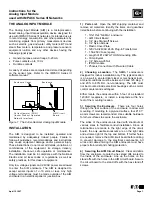
CNC Z32 - Programming Guide (LATHES)
Alive axes management (G28, G29)
One axis is defined as “alive” when its position is controlled by the NC, also if it is stand still.
•
The
function
G28
(modal, with stop) asks the NC to maintain under control the axis also when it is not
interested by the current move (alive axis).
After G28 the axis name (i.e. X) desired as alive must be specified, for instance:
G28X
Only one axis can be specified, choosing among those defined as continuous in the machine setup.
If more than one axis are desired as alive axes, it is possible to program G28 more than once, in the same
or subsequent lines. Example:
G28Z G28A
asks to maintain always under control the axes Z and A.
Some axes (defined in the machine setup) may be defined as alive since power on: at every program start
(or after a reset) the alive/not alive axes situation defined in the machine setup is restored.
Note:
Depending on machine setup, it is possible to define the axes as “alive at reset”. With this setup
all axes programmed as alive (with G28) or abandoned (with G29) restore their alive/not alive axes
state also after a reset or next power on.
It is allowed, without effect, the request to activate one already alive axis.
•
The
function
G29
(modal, with stop) asks the NC to abandon the specified axis.
After G29 the axis name (i.e. X) to be abandoned must be specified, for instance:
G29 X
Only one axis can be specified, choosing among those defined as continuous in the machine setup.
If more than one axis have to be abandoned, it is possible to program G29 more than once, in the same or
subsequent lines. Example:
G29X G29A
asks the NC to abandon the axes X and A.
It is allowed, without effect, the request to deactivate one already not alive axis.
Note on programming not alive axes
−
If the part-program contains a movement for a not alive axis, the axis is automatically activated,
moved and then abandoned, but only if its physical position doesn’t coincide with the programmed
one.
The NC considers the physical position coincident with the programmed position if the error is less
than the positioning error defined in the setup (normally some hundredth of millimeter).
Some problem may arise if the error is very close to the tolerance. If the measured position of the
not alive axis (which shouldn’t move) changes a little, bringing the error over the setup threshold,
an alarm CN1513 may be issued.
The measured position may oscillate by some transducer count, still remaining inside the
positioning threshold; the threshold override may thus happen if the position is already close to the
tolerance limit. Typical examples are:
−
a turntable (or other axis) during the mechanical lock may have a little movement bringing the axis
very close to the maximum setup error allowed
−
programming a little movement for a not alive axis, corresponding to a space very close to the
positioning threshold
In these cases it is recommended to not use the automatic activation of a not alive axis, but to
force it alive or not, directly with part-program instructions.
30
Summary of Contents for CNC Z32 Florenz Series
Page 2: ......
















































